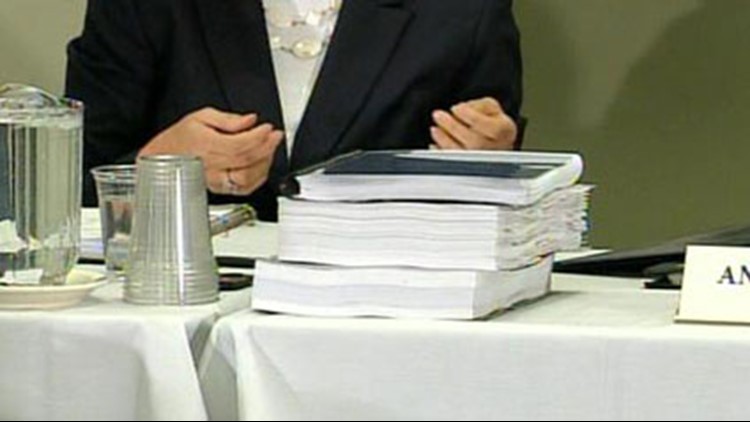Two new reports on the Indiana State Fair stage collapse that killed seven people say the rigging was poorly constructed and the emergency response was not adequate.
Engineering firm Thornton Tomasetti found the stage rigging and bracing woefully inadequate, adding if it had been up to code the stage should have been able to withstand winds far greater than the ones that caused the collapse.
Another firm, Washington-based Witt Associates, found serious problems with the disaster preparations and emergency response, citing missed weather warnings and a murky chain of command.
Also, the fair's executive director, Cindy Hoye, will be keeping her job despite the highly critical report and her own offer to resign.
13 Investigates first uncovered several of the problems included in Thursday's report.
The findings also echoed what the Indiana Department of Labor found: No inspections of the rigging, problems with the support of the structure and no one clearly in charge, making timely decisions for the public's safety.
"We are and always will be heartbroken about what happened on the August 13th," said Hoye at a news conference Thursday.
Structural problems
Eight months after one of the worst tragedies in Indiana history, structural investigators determined the stage rigging collapsed under a three-second wind gust of 59 mph. It didn't have enough support to hold its load.
"It begins a free-fall type of situation and ultimately collapses. Once gravity had taken over there was no way for the structure to support itself," said Scott Nacheman, Thornton Tomasetti.
Investigators say the rigging had no cross bracing but was tethered to "Jersey barriers." Those barriers began to slide under 33-mph winds - well below expected standards and before the tarp blew off.
Nacheman said the tarp created "a parachuting effect. It did add a significant amount of drag to the structure. By the time that released, the other elements had already failed."
The Thornton Tomasetti report found that the Jersey barrier ballast system used by the stage had "grossly inadequate capacity to resist both the minimum code-specified wind speed and the actual wind speed that was present at the time of the failure."
The report also stated that even if the ballast system had provided sufficient resistance, the synthetic webbing ratchet straps and wire rope guy lines used did not have sufficient strength to resist the wind gust - although it was actually less magnitude than code-specified requirements.
The report said that industry standards call for temporary structures to withstand a wind speed of 68 mph. On August 13, 2011, the wind speed was 59 mph, according to Thornton Tomasetti's report.
He also said that the stage was "over-stressed and overloaded."
No expert inspections
It's more bad news for owners Mid America Sound and the company that engineered the rigging. Investigators say with no expert inspections, those who erected the structure were left in the dark about critical safety design.
"Nowhere in there does it describe the limitations that the end user would be able to draw from it," said Nacheman.
Structural failures combined with the lack of an adequate emergency response planning and no one clearly in charge created a recipe for disaster.
Backstage confusion
Witt & Associates reviewed the State Fair Commission and found systemic failures in evacuating concert goers at the first sign of a severe thunderstorm warning.
"At that time at 8:39, we still had approximately eight and a half minutes to move people away from the structure. They did not have that information to make a decision," said Kenneth Mallette, Witt & Associates.
Investigators say no one heard the last alert of severe weather in the joint operations center. But Cindy Hoye, who knew of the impending weather, had begun to ask Sugarland to delay the show. The band's tour manager, Helen Rollins, was pushing for the band to go on.
"Ms. Rollins had been monitoring the weather and Rollins said, 'It is only rain; we can play,'" said Mallette.
Investigators say Hoye did ask Sugarland and Rollins to delay the concert twice, but when Rollins refused, Hoye gave in.
"Rollins wanted to start at 8:50 and Hoye agreed," said Mallette.
After the second request, Hoye went along with Sugarland and told the announcer verbatim what to say. It did not include orders to evacuate.
"The overall state of preparedness was not adequate for an event of that magnitude," said Charlie Fisher, Witt & Associates.
Hoye to stay on
For the first time since the collapse, State Fair Commission Chairman Andre Lacy reveals Hoye offered to resign her position.
"She offered to resign on a number of occasions. But I've asked her to see it through. The commission is clearly setting the expectations that weren't defined before," said Lacy.
Lacy said the decision to keep Hoye on as executive director was a unanimous one.
In the end, investigators say it was off-duty State Trooper Brad Weaver who insisted on the evacuation. By the time he convinced Hoye to make the announcement, it was too late.
"For me personally, not a night goes by that I don't replay those events over and over and over again. But every morning I pray for peace and hope for the people that have been impacted by this tragedy," said Hoye.
"These investigations were never intended as a means of placing blame," Lacy said at the start of the meeting.
"Anyone who knows me knows how much I love the Indiana State Fair and how much I treasure this institution. Still, I understand the need for accountability and I've always been honored and humbled to be the head of this great institution and I pledge to continue to serve those who have entrusted it to me. Hindsight is an incredible teacher and that's all we have right now," Hoye added.
Mid America Sound attorneys are in West Virginia taking depositions from Sugarland and have not reviewed these latest findings.
Accountability
Despite the findings and promises of accountability by Gov. Mitch Daniels, Chairman Andre Lacy deflected blame and individual responsibility for the systemic failures.
"Chairman, what responsibility do you take for what has happened?" Eyewitness News asked Lacy.
"I expect the commission to define clear expectations," he said.
All around troubling findings for State Representative Ed DeLaney, who led lawmakers in approving more money for the families of the seven who died and the dozens of others injured. He also supported new laws requiring stage inspections.
"It's pretty disturbing. I think we've taken some good steps. We passed some temporary legislation that should address problems the next year and half, but we've got to get serious about this," he said.
Recommendations
Hoye said the findings revealed Thursday will help determine future safety policy at the fair.
"They're extremely important for us to use as a road map to move the Indiana State Fair forward. Unfortunately and sadly, these reports can't change the past. It is our responsibility to move forward," Hoye said.
"The reports are going to guide us to become a model for other fairs in Indiana, throughout the country for other festivals and events, throughout the world. My hope today is that in some small way, the changes that come from what we have all learned will honor the memories of those we lost on August 13," she said.



